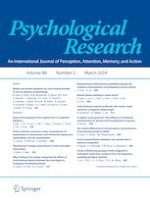18-08-2023 | Research
Similarities of SNARC, cognitive Simon, and visuomotor Simon effects in terms of response time distributions, hand-stimulus proximity, and temporal dynamics
Gepubliceerd in: Psychological Research | Uitgave 2/2024
Log in om toegang te krijgenAbstract
The spatial-numerical association of response codes (SNARC) and Simon effects are attributed to the same type of conflict according to dimensional overlap (DO) theory: the congruency of task-irrelevant spatial information and the selected response (e.g., left or right). However, previous studies have yielded inconsistent results regarding the relationship between the two effects, with some studies reporting an interaction while others did not. This discrepancy may be attributed to the use of different types of Simon effects (visuomotor and cognitive Simon effects) in these studies, as the spatial codes associated with these two types of Simon effects are distinct (exogenous and endogenous, respectively). The aim of this study was to address these inconsistencies and gain a better understanding of the similarities and differences in spatial representations generated by spatial location, semantic information, and numerical information. We attempted to classify the relationships among the SNARC and Simon effects. Specifically, the visuomotor Simon, cognitive Simon, and SNARC effects were compared from three perspectives: the response time (RT) distribution, hand-stimulus proximity, and temporal dynamics (with the drift diffusion model; DDM). Regarding RTs, the results showed that the visuomotor Simon effect decreased with increased values of RT bins, while the cognitive Simon and SNARC effects increased. Additionally, the visuomotor Simon effect was the only effect influenced by hand-stimulus proximity, with a stronger effect observed in the hand-proximal condition than in the hand-distal condition. Regarding the DDM results, only the visuomotor Simon effect exhibited a higher drift rate and longer non-decision time in the incompatible condition than in the compatible condition. Conversely, both the SNARC and cognitive Simon effects exhibited an inverse pattern regarding the drift rate and no significant difference in non-decision time between the two conditions. These findings suggest that the SNARC effect is more similar to the cognitive Simon effect than the visuomotor Simon effect, indicating that the endogenous spatial-numerical representation of the SNARC effect might share an underlying processing mechanism with the endogenous spatial–semantic representation of the cognitive Simon effect but not with the exogenous location representation of the visuomotor Simon effect. Our results further demonstrate that the origin of spatial information could impact the classification of conflicts and supplement DO theory.
